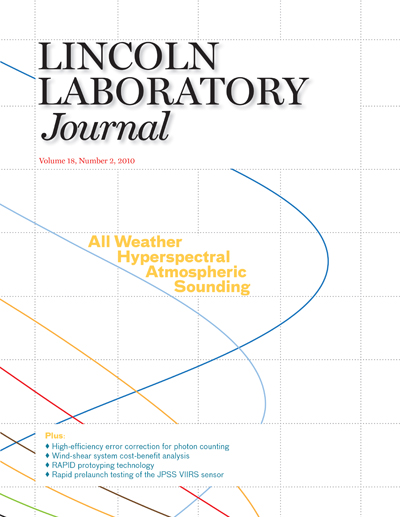Lincoln Laboratory Journal - Volume 18, Number 2

RAPID Prototyping Technology
Huy Nguyen and Michael Vai
Rapid Advanced Processor In Development (RAPID) is a prototyping technology that accelerates the development of state-of-the-art processor systems, particularly those involving custom boards and firmware. This technology enables large productivity gains in prototyping and a significant reduction of development times from system concept to operation.
All-Weather Hyperspectral Atmospheric Sounding
William J. Blackwell, R. Vincent Leslie, Michael L. Pieper, and Jenna E. Samra
Development of a new hyperspectral microwave (HM) remote sensing modality for all-weather atmospheric sounding has been enabled by recent advances in microwave device technology driven largely by the commercial communications sector. A spaceborne HM sounder would substantially improve weather forecasting by offering both cloud penetration and high vertical resolution.
Wind-Shear System Cost-Benefit Analysis
Robert G. Hallowell and John Y. N. Cho
Mitigating thunderstorm wind-shear threats for aircraft near the ground has been an important issue since the 1970s, when several fatal commercial aviation accidents were attributed to wind shear. Updating the knowledge base for airport wind-shear exposure and effectiveness of detection systems has become critical to the Federal Aviation Administration as they consider options for aging systems and evaluations of new systems.
Rapid Prelaunch Testing of the JPSS VIIRS Sensor
Carl H. Fischer
MIT Lincoln Laboratory has an extensive history helping develop hardware and communications systems for previous environmental monitoring satellites and is assisting, to varying degrees, with the design and development of all major sensors for the next-generation Joint Polar Satellite System (JPSS). Recently, Lincoln Laboratory has leveraged this experience to develop a Data Analysis and Decision Support cluster that allows scientists to extract, process, and plot statistics expeditiously for tens of gigabytes of sensor data contained across hundreds of data files. These "quick looks," or rapid assessments of the health and sufficiency of test data, have been implemented for the thermal-vacuum test phase of one JPSS sensor, the visible/infrared imager/radiometer suite (VIIRS), which will provide important environmental data, including most of the atmospheric cloud and surface information needed by weather forecasters.
High-Efficiency Error Correction for Photon Counting
Andrew S. Fletcher
Pulse-position modulation (PPM) using a photon-counting receiver produces an extremely sensitive optical communications system, capable of transmitting multiple bits of information for each received photon. Such impressive sensitivity requires powerful error-correction codes that must be computationally efficient to enable high data throughput. Fountain codes combine performance and efficiency for a narrow class of channels, known as erasure channels. A potential application for fountain codes is the photon-counting PPM receiver, which is an approximate erasure channel and includes occasional channel errors. This non-ideal behavior requires a nontraditional use of fountain codes. With a carefully constructed architecture, fountain codes provide the desired efficient error correction to the photon-counting PPM receiver.
Lab Notes
- Let a Robot Do the Work › They're not automatons, but these robots map, track, and locate things for you.
- Uncoiling DNA Analysis › Rapid DNA-fingerprinting method would identify biological organisms in the field.
- A Bright Idea › Simple tweaks turn tiny diode lasers into powerhouses.
- A Route to Energy Savings › Predictive control of plug-in hybrid vehicles will analyze your route to work and optimize battery and gas usage.
- Vision Correction › Two projects should help astronomers see further across the universe.
Looking Back
- Wideband Radar › Lincoln Laboratory researchers built the world's first long-range wideband radar and launched a new era in defense radar and satellite imaging capability.